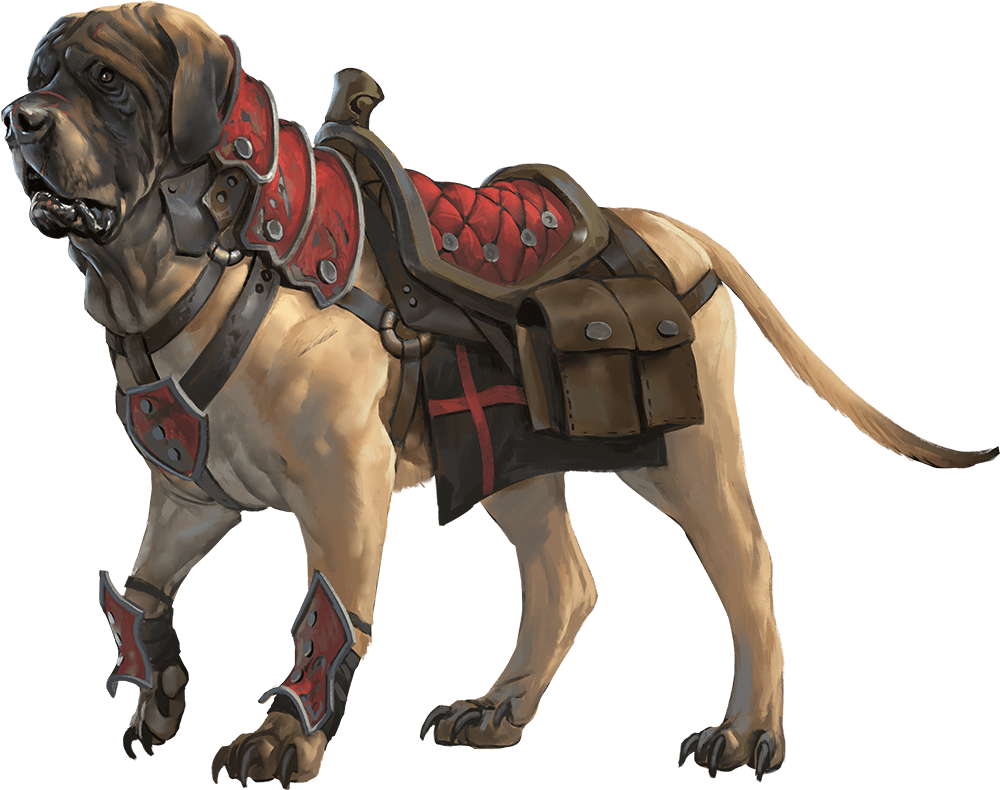
-

-
| - | - | - | - | - |
| Dungeons & Dragons | - | Dragon magazine | - | The Dragon #29 |
After playing Dungeons & Dragons for awhile, and working
with
the average non-player character (NPC) hireling, one may become disillusioned
with them. They are unpredictable, at times shifty, and their
demands constantly bombard their poor masters. Some hirelings are
better than others, obviously, but it is difficult to place one’s trust
in one
too explicitly. Therefore, I have developed an alternative.
For thousands of years man has been taming dogs, birds, and like
animals for protection and other uses. Dogs were used to help in tracking
and hunting and to protect encampments during the night. Birds of
all kinds, from eagles to thrushes, were used in many aspects of
medieval life. Animals were safer than humans to have around; after
all,
a dog won’t wait until his master has gone to sleep at night to attack
him.
Their demands are small enough; all they need is a bit of meat each
day
to keep them happy. Therefore, it is my belief that it would be highly
profitable to introduce such animals into your campaign. The following
list deals with a few animals and how they might be handled.
WILD DOGS: These small, fierce canines, once tamed, have a +2
on
their loyalty roll. They cost 50 gold pieces (G.P.) untrained, and
150
G.P. trained. When trained they will attack on command, retrieve any
small item in sight on command, and attack threatening animals,
monsters, or men when their master is not able to command them.
They have hit dice of 1 + 1, have an armor class of 7, and move 15
inches per turn.
WAR DOGS: These large, ferocious, domestic animals are even more
loyal than their wild cousins, having a +4 on their loyalty roll. They
cost
100 G.P. untrained, and 200 G.P. trained. Their training is like that
of a
wild dog, but they can also pull 800 G.P. weight in a cart or sled,
alone
or in teams, i.e. a team of eight would be able to pull 6400 G.P. weight.
They have hit dice of 2 + 2, have an armor class of 6, and move 12
inches per turn. Their single attack does 2-8 points of damage.
WOLVES: Trained wolves conform mainly to the statistics shown
for
war dogs, although they move at 18 inches per turn, and their single
attack does 2-5 points of damage.
DIRE WOLVES: Trained dire wolves should be treated as wolves
which
cost 200 G.P. untrained and 300 G.P. trained. They take 3 + 3 dice
of
damage, and their single attack does 2-8 points of damage.
WINTER WOLVES AND WARGS: These animals and others like them
should not be included in the category of trained animals due to their
superior intelligence and other qualities.
PIGEONS: These small swift birds are highly useful in many situations.
Although they do not fight, they have an excellent homing ability which
allows them to be used as messengers. It would be wise to have someone
from the town or city that a character is based in to check the pigeons’
nesting place for messages from time to time. (Messages are
useless unless they are received.) Pigeons take one point of damage,
have an armor class of 8, and fly 28 inches per turn. They cost 10
G.P.
RAVENS: These birds, though small, are fierce fighters. The main
advantage
in using these birds is the fact that they always attack the eyes,
blinding their opponents. When trained they attack on command. They
take one point of damage, have an armor class of 7, and fly 28 inches
per turn. Due to their small size and high speed, they attack twice
per
melee round. They cost 10 G.P. untrained and 15 G.P. trained.
HAWKS OR FALCONS: These fair sized birds of prey are excellent
fighters, and are fairly easily trained. They can be purchased untrained
at a price of 20 G.P., and 30 G.P. trained. They attack on command
when trained. They take 1 + 1 dice of damage, have an armor class of
7, and fly at 38 inches per turn. They attack thrice each melee round
(2
claws, 1 beak) doing 1-4/1-4/1-8 points of damage respectively.
GOLDEN EAGLES: These large birds of prey are difficult to train.
They
have a -1 on their loyalty score, though they rarely attack their masters.
The cost is 50 G.P. untrained, and 100 G.P. trained. They take 2
dice of damage, fly at 38 inches per turn, and have an armor class
of 7.
They get 3 attacks per melee round (2 claws, 1 beak), doing 1-6/1-6/
1-8 points of damage respectively. When trained they will attack on
command.
BALD EAGLES: These birds are even larger than Golden Eagles.
Like
Golden Eagles, they are free-willed, with a -2 on their loyalty score,
though they will almost never attack their masters. When trained, they
will attack on command. They take 3 dice of damage, have an armor
class of 7, and fly at 38 inches per turn. They attack thrice per melee
round (2 claws, 1 beak) doing 1-6/1-6/2-8 points of damage respectively.
They cost 100 G.P. untrained, and 150 G.P. trained.
It should be noted that trained animals are not affected by greed or
pride, but they do have a morale roll like other N.P.C.s. When failing
to
make their morale, animals will generally try to escape. Animals will
only attack their masters during an act of cruelty.
Many other animals can be trained. Feel free to change the statistics
of the animals listed, or invent new ones. After, all, these are not
rules to be used with trained animals, they are just my conception
of
how they could be handled.